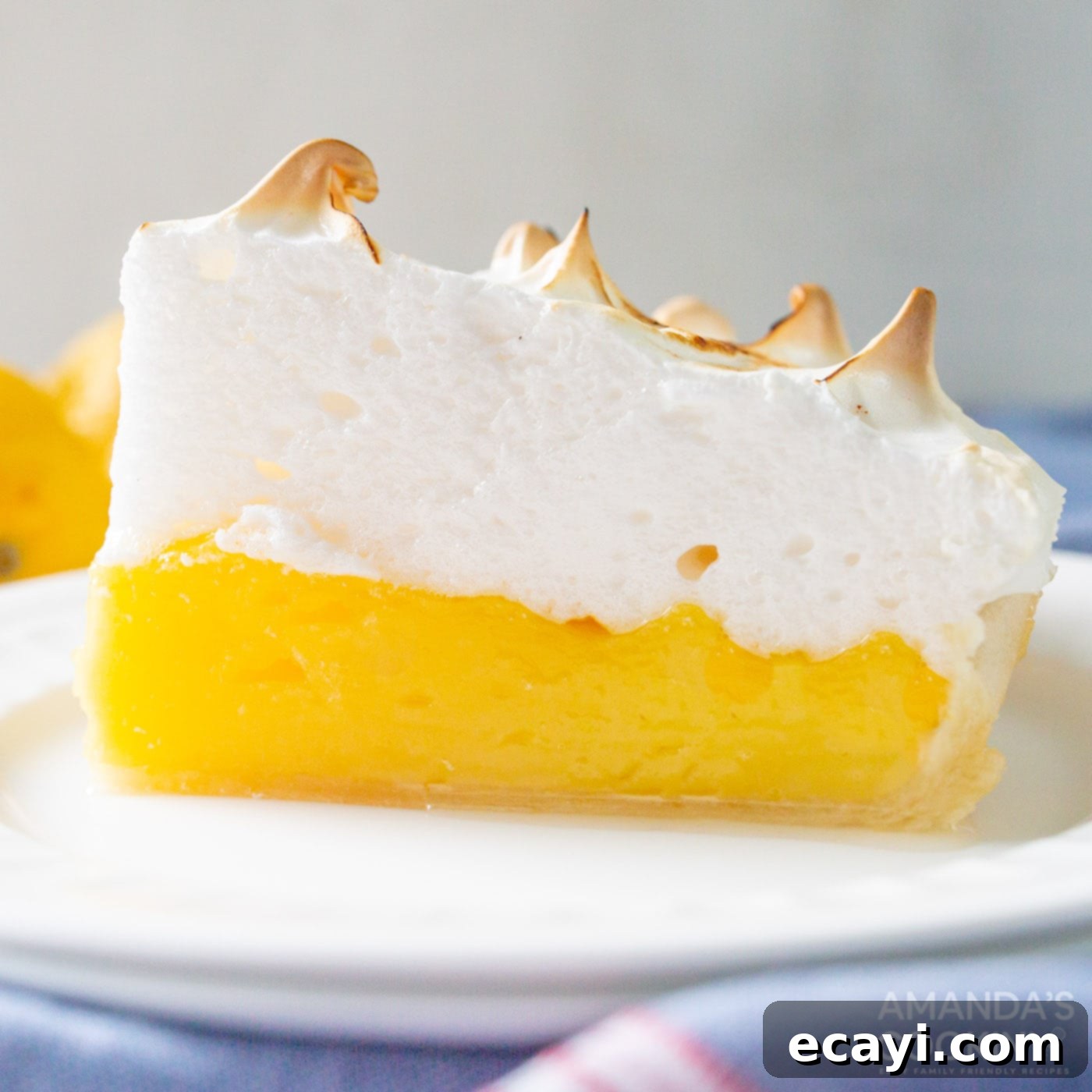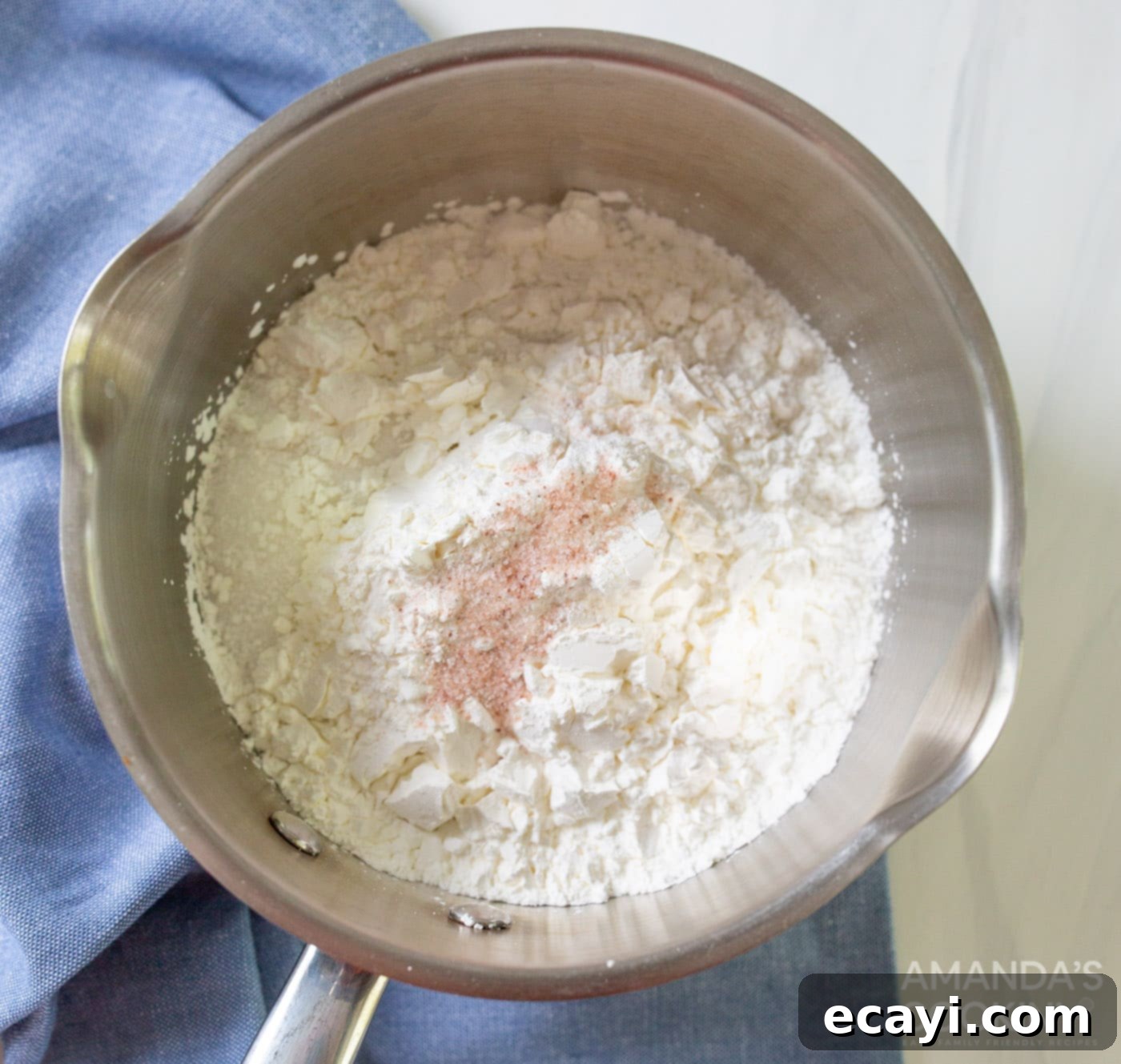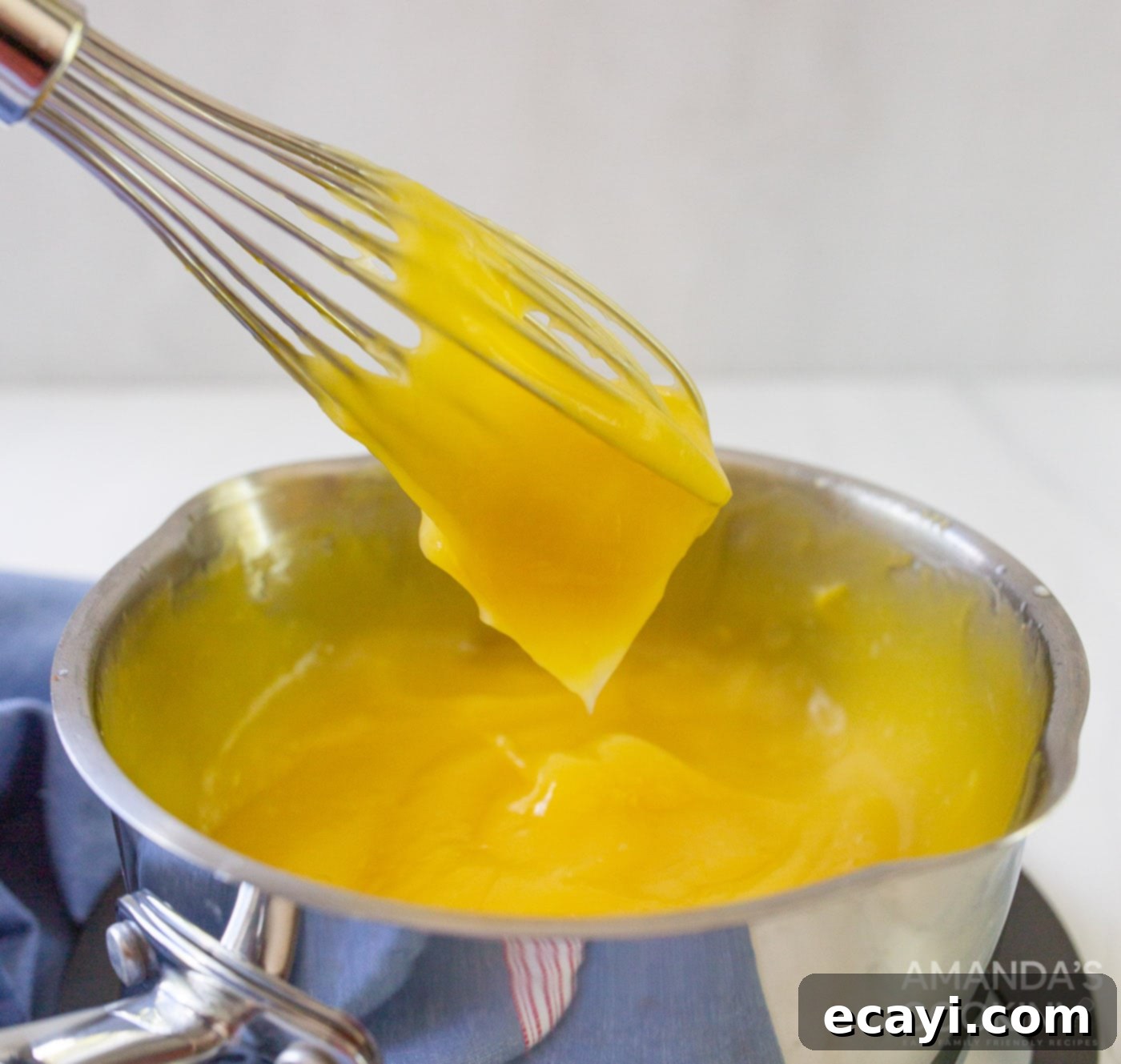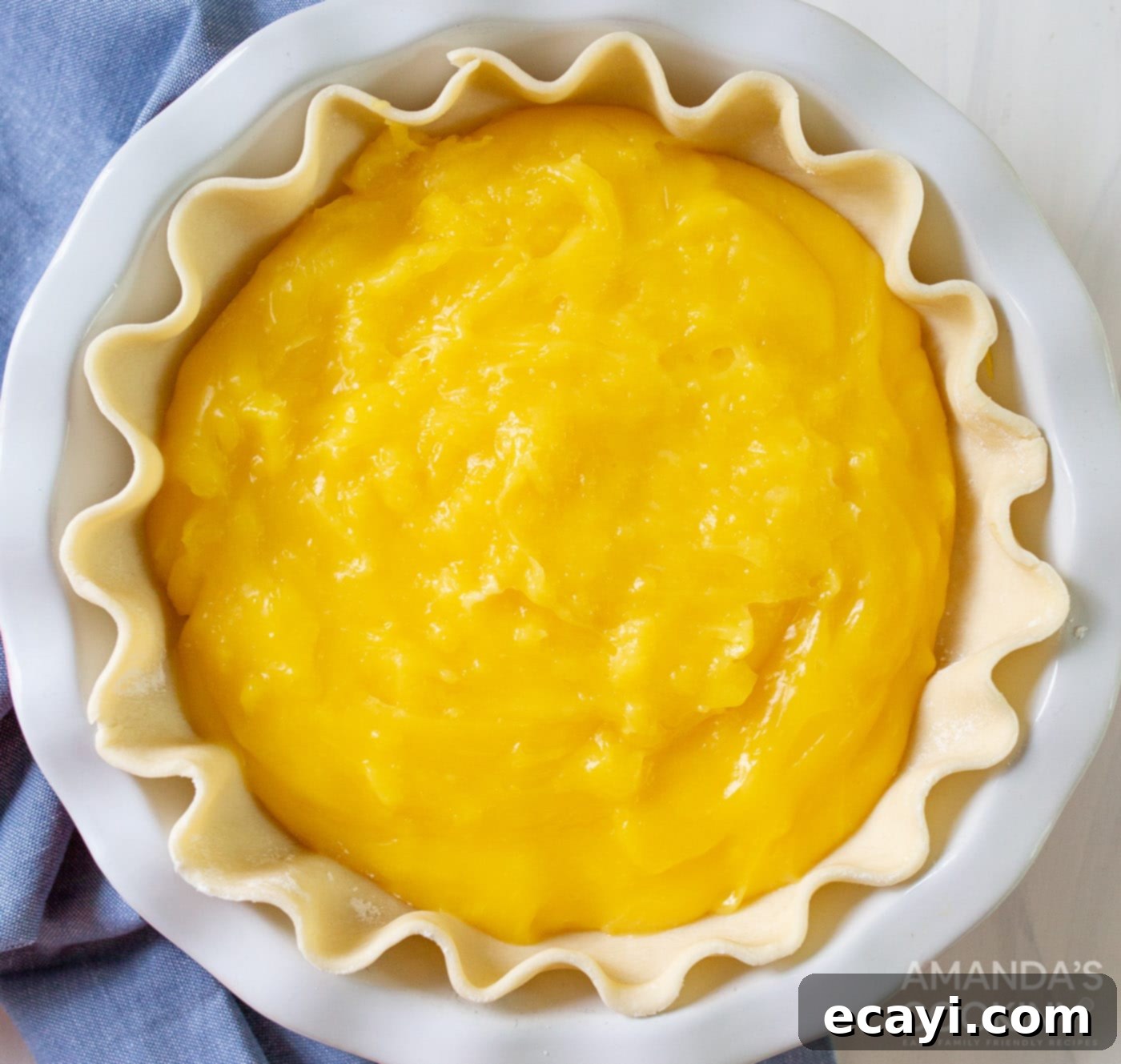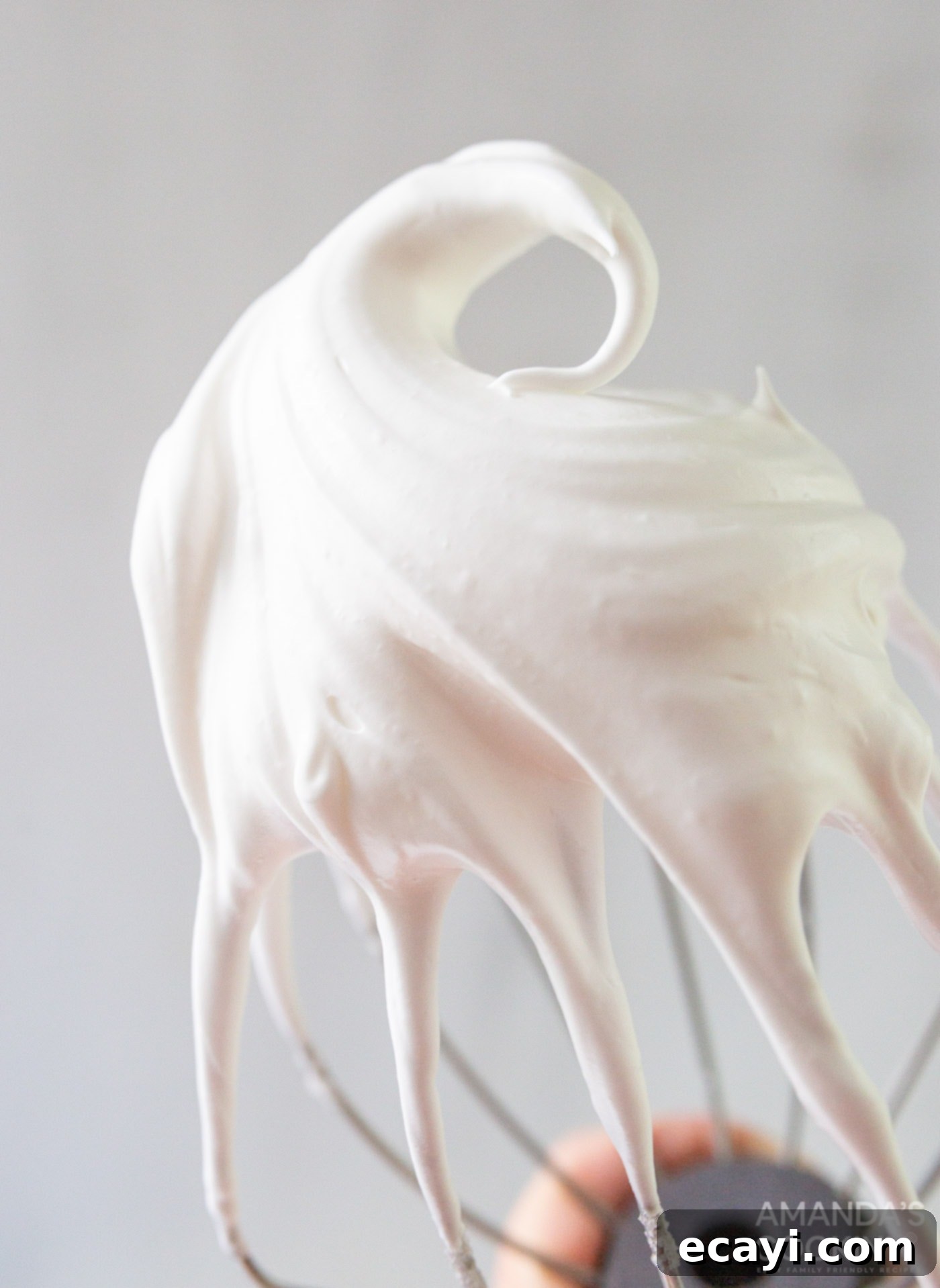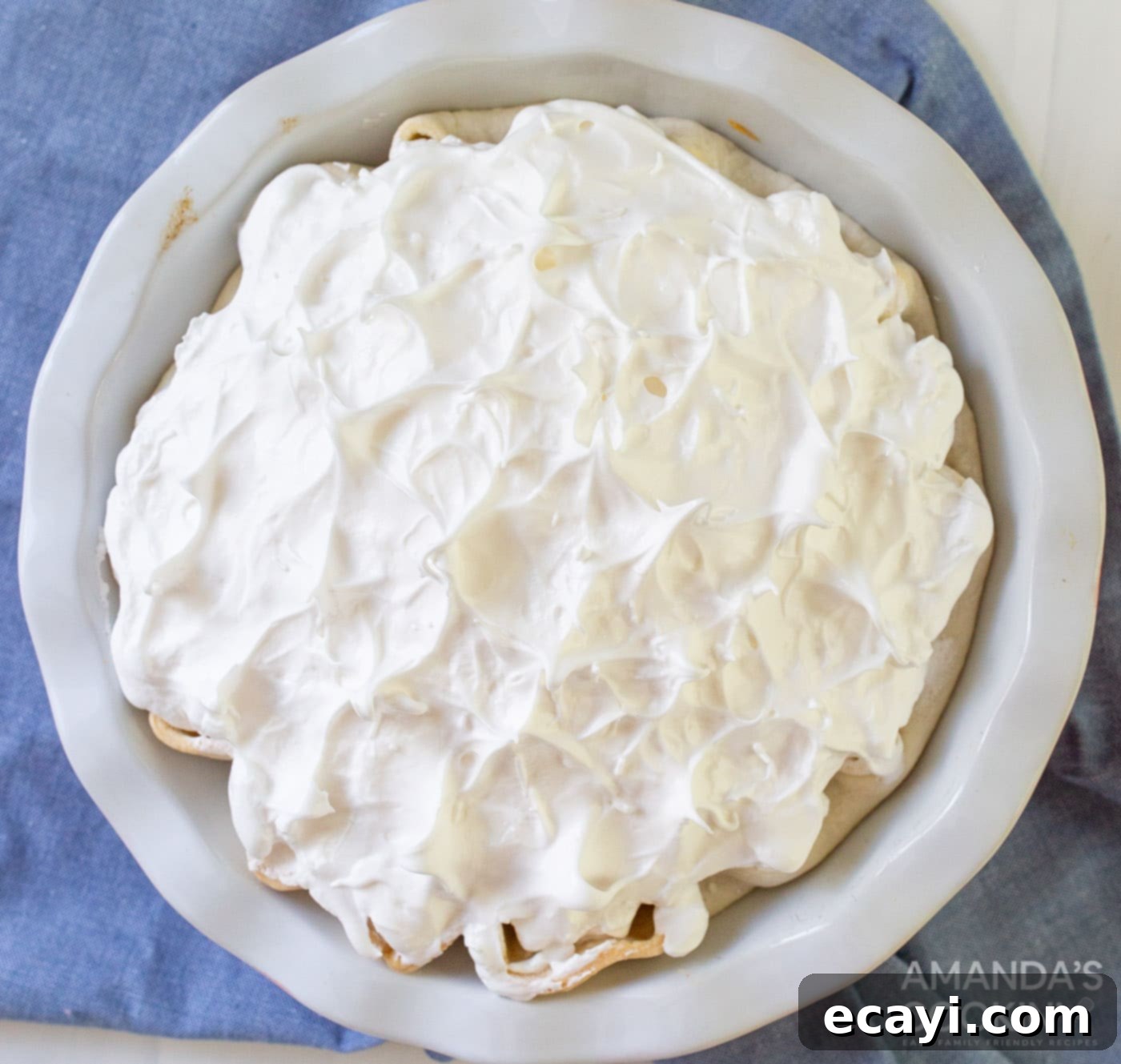The Ultimate Guide to Baking a Flawless Lemon Meringue Pie: Sweet, Tangy, and Perfectly Pillowy
There are few desserts as iconic and universally loved as a classic lemon meringue pie. With its irresistible combination of a crisp, buttery crust, a vibrant, tangy lemon custard, and a towering, cloud-like meringue topping, each forkful delivers a symphony of textures and flavors. This delightful treat is a true testament to the simple elegance of baking, offering a refreshing citrus burst that perfectly balances its sweet components. Whether you’re a seasoned baker or just starting your culinary journey, mastering the art of lemon meringue pie is a rewarding experience that will impress friends and family alike. Get ready to dive into a recipe that promises a show-stopping dessert, a perfect blend of tart and sweet that truly hits all the right spots.
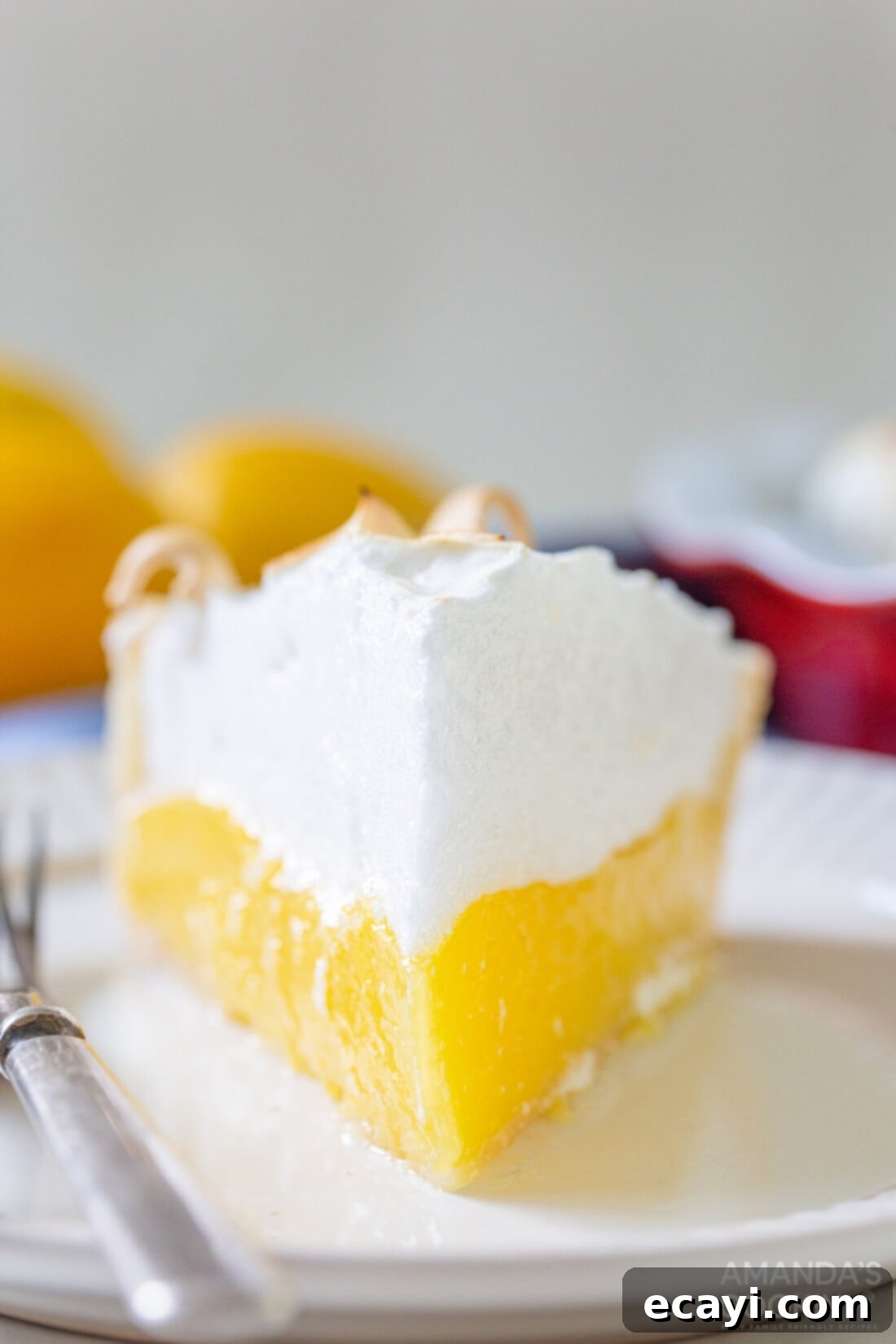
Why This Lemon Meringue Pie Recipe Stands Out
Crafting the perfect lemon meringue pie can sometimes feel like a daunting task, but this recipe is designed to simplify the process while ensuring spectacular results every time. We’ve fine-tuned each element to guarantee a pie that’s not only incredibly delicious but also visually stunning, with a stable meringue that won’t weep and a custard that sets beautifully. Many recipes can lead to common pitfalls like a runny lemon filling or a deflated, watery meringue, but our detailed steps and expert tips will guide you past these challenges, resulting in a dessert you’ll be proud to serve.
The magic lies in the balance of ingredients and precise techniques. Our lemon custard strikes the ideal sweet-to-tart ratio, thanks to fresh lemon juice and zest, providing that signature bright, zesty flavor. The custard’s consistency is achieved through careful cooking and the right amount of cornstarch, ensuring it’s smooth, creamy, and holds its shape once chilled. For the meringue, we focus on proper egg white preparation and the stabilizing power of cream of tartar, yielding a fluffy, glossy topping that holds its peaks and browns beautifully without weeping. This classic lemon meringue pie is surprisingly simple to make when you follow our quick pointers and careful instructions, making it an approachable recipe for bakers of all skill levels.
Looking for a variation that’s perfect for gatherings? We’ve also adapted this delicious recipe into lemon meringue pie bars. These bars are fantastic for potlucks, holiday parties, or any event where you need to feed a crowd, offering 16 generous servings without the hassle of making multiple whole pies. They capture all the beloved flavors and textures of the pie in a convenient, sliceable format.
RELATED: If you enjoy nostalgic desserts, you might also like this recipe – Root Beer Float Pie
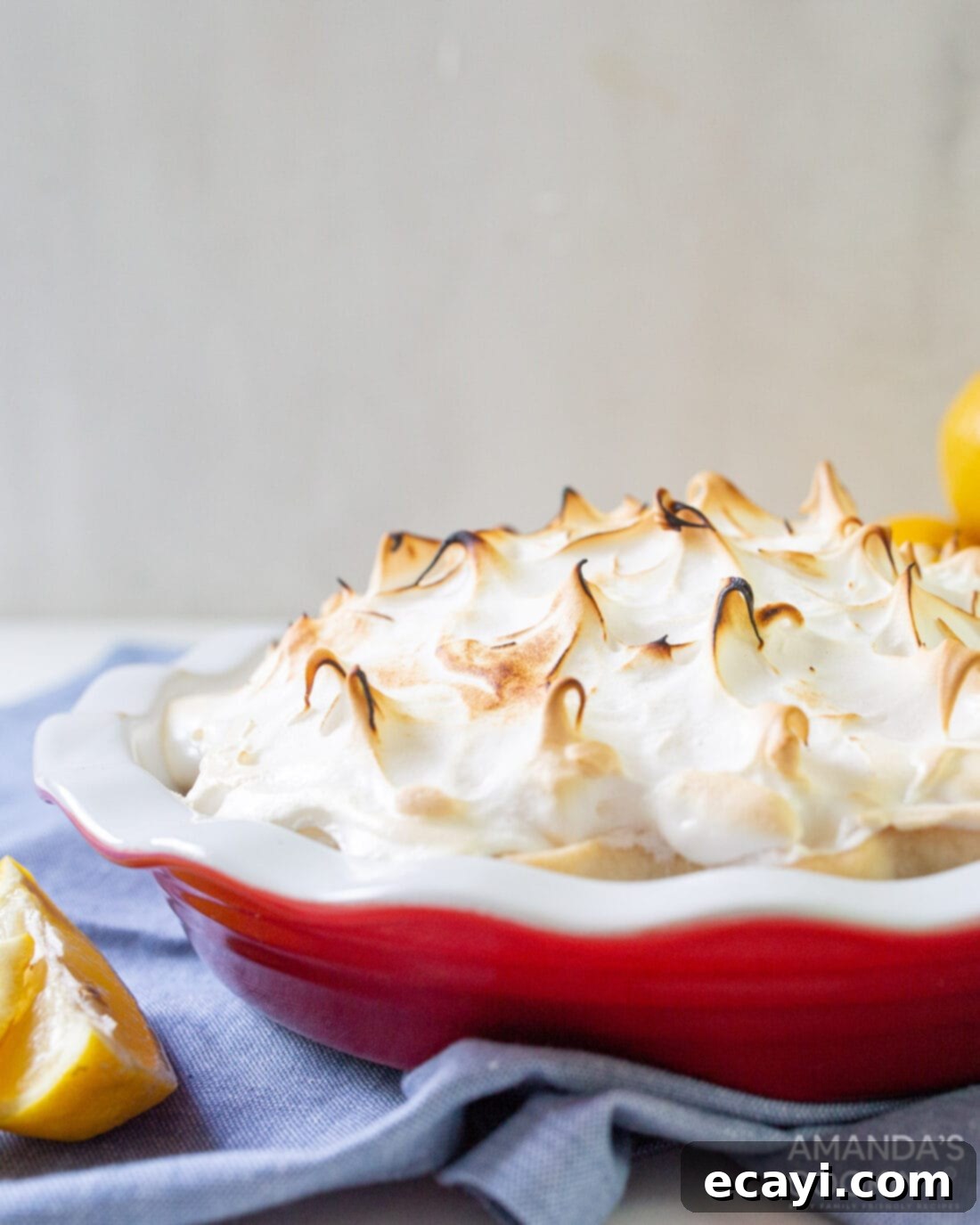
Essential Ingredients for Your Perfect Lemon Meringue Pie
Crafting an exquisite lemon meringue pie begins with gathering high-quality ingredients. Each component plays a vital role in achieving the signature taste and texture of this beloved dessert. Below, we break down the key ingredients you’ll need and offer tips for selecting and preparing them. For precise measurements, always refer to the printable recipe card at the very end of this detailed post.
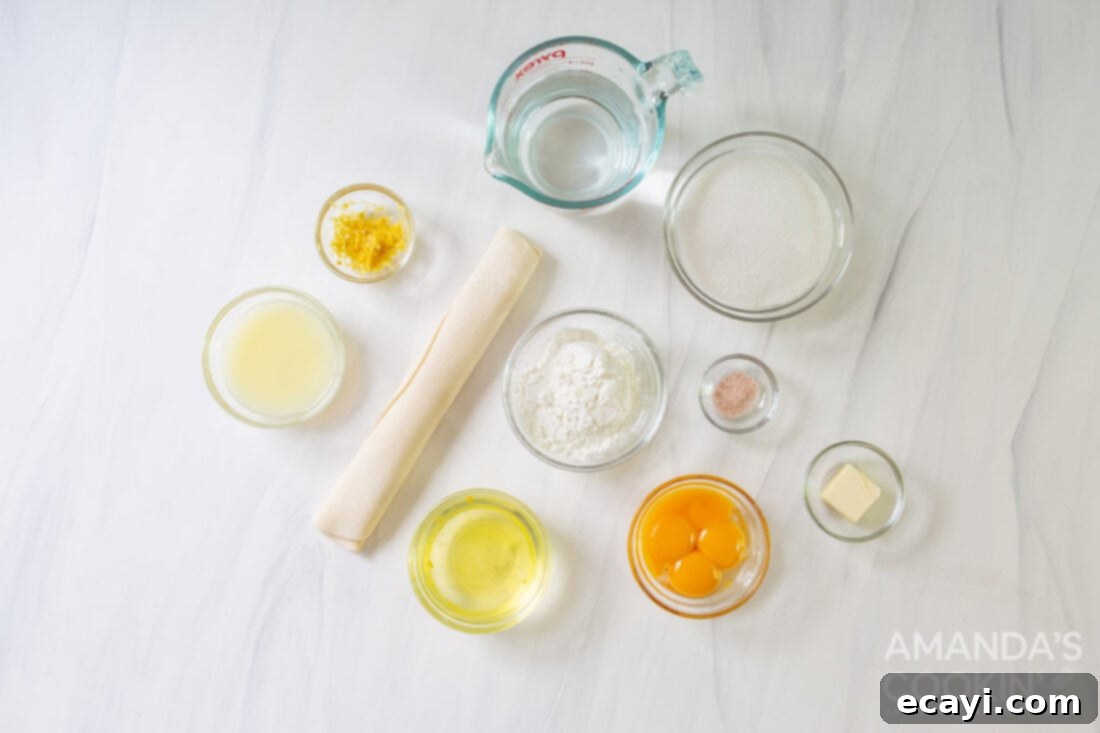
The Meringue: Your Pillowy Topping
The meringue is arguably the most visually stunning part of a lemon meringue pie, offering a light, airy contrast to the rich lemon custard. While it can sometimes be perceived as tricky, understanding a few key elements will lead to success.
- Egg Whites: Use fresh, large eggs, ensuring they are at room temperature before separating. Cold egg whites are more difficult to beat to a significant volume. Be meticulous when separating eggs; even a speck of yolk can prevent the whites from stiffening properly.
- Cream of Tartar: This acidic salt is your secret weapon for stable meringue. It helps to stabilize the egg whites, allowing them to hold more air and preventing them from deflating or weeping.
- Granulated Sugar: Gradually adding sugar to the whipped egg whites helps create a glossy, stable meringue. Don’t add it all at once, and make sure it’s fully dissolved to avoid a grainy texture.
The key to a perfect meringue is to beat the egg whites just enough—until soft peaks form before sugar addition, and stiff, glossy peaks after sugar is fully incorporated. Overbeating can cause the meringue to become dry and brittle.
The Lemon Custard: The Tangy Heart of the Pie
The lemon custard filling is what gives this pie its signature bright and zesty flavor. Achieving a perfectly smooth, thick, and tangy custard is crucial for a delightful eating experience.
- Fresh Lemon Zest and Juice: This is non-negotiable for the best flavor! Bottled lemon juice simply doesn’t compare to the vibrant, aromatic punch of freshly squeezed lemons. The zest contains essential oils that deepen the lemon flavor without adding extra acidity. Aim for about 3-4 medium lemons to get the required ½ cup of juice.
- Sugar: Balances the tartness of the lemon, creating a harmonious sweet and tangy profile.
- Cornstarch: This acts as the primary thickening agent for the custard, ensuring it sets firmly yet remains wonderfully smooth. Proper whisking is essential to prevent lumps.
- Egg Yolks: Provide richness and help thicken the custard, contributing to its creamy texture. Tempering the egg yolks (slowly adding hot mixture to yolks) is vital to prevent them from scrambling.
- Butter: A touch of butter stirred in at the end adds a silky mouthfeel and a subtle richness to the filling.
The Crust: The Foundation of Flavor and Texture
The crust provides the essential base and a delightful textural contrast to the soft filling and meringue. While a homemade crust offers unparalleled flavor and flakiness, a high-quality store-bought option makes this recipe incredibly convenient.
- Pre-made Pie Dough: For ease and to save time, we’ve opted for a pre-made 9-inch pie dough. This is a fantastic shortcut that doesn’t compromise the overall enjoyment of the pie.
- Homemade Pie Dough: If you prefer to bake from scratch, you can certainly use your favorite homemade pie dough recipe. A good all-butter crust or a combination of butter and shortening will yield excellent results.
Regardless of your choice, blind baking the crust is a critical step to ensure it is crisp and golden, preventing a soggy bottom once the luscious lemon custard is added.
Step-by-Step Guide: How to Make Lemon Meringue Pie
These step-by-step photos and detailed instructions are provided to help you visualize each stage of making this incredible lemon meringue pie. For a quick reference or to print the full recipe with exact measurements and ingredients, you can Jump to Recipe at the bottom of this post.
- Prepare and Bake the Crust: Begin by unrolling your 9-inch pie crust into a pie plate. Prick the bottom and sides thoroughly with a fork. To ensure the pie shell bakes flat and doesn’t shrink, line it with parchment paper and fill it with pie weights, dried beans, or rice. Bake according to package instructions until golden brown. Once baked, remove the weights and parchment, and allow the crust to cool completely on a wire rack. This “blind baking” step is crucial for preventing a soggy bottom.
- Start the Lemon Custard: In a medium saucepan, combine the granulated sugar, salt, and cornstarch. Whisk these dry ingredients together to ensure they are well combined and lump-free. Slowly add the hot water, whisking continuously to prevent lumps from forming. Place the saucepan over medium-low heat and continue to whisk without interruption for 5 to 10 minutes. The mixture will gradually thicken and become smooth, resembling a translucent paste. Once it reaches this consistency, remove the saucepan from the heat.

- Temper the Egg Yolks: In a separate bowl, lightly beat the four egg yolks until they are uniformly yellow. To prevent the egg yolks from scrambling when added to the hot cornstarch mixture, you need to “temper” them. Slowly whisk about 1/4 cup of the hot cornstarch mixture into the beaten egg yolks. Continue this process, adding small amounts of the hot mixture to the yolks and whisking vigorously, until about half of the cornstarch mixture has been incorporated into the yolks. This gradually raises the temperature of the yolks.
- Combine and Thicken the Custard: Now, pour the tempered egg yolk mixture back into the saucepan with the remaining cornstarch mixture. Add the butter to the saucepan. Return the saucepan to medium-low heat and whisk continuously until the butter is completely melted and the custard is thick, smooth, and coats the back of a spoon. The custard should be bubbling gently. This step further cooks the egg yolks and activates the cornstarch to create a rich, stable filling.
- Add Lemon Flavoring: Once the custard has reached the desired thickness, remove it from the heat. Stir in the fresh lemon zest and freshly squeezed lemon juice. Whisk thoroughly until all the lemon zest and juice are fully combined into the warm custard. The aroma will be incredible at this point!

- Chill the Custard: Pour the hot lemon custard immediately into the pre-baked and cooled pie crust. To prevent a skin from forming on the surface of the custard (which can lead to cracking), gently press a piece of plastic wrap directly onto the surface of the filling. Allow the pie to cool on the counter for about 30 minutes, then transfer it to the refrigerator to chill for a minimum of 2 hours, or until the custard is completely set and firm. This chilling time is crucial for the pie to hold its shape.

- Prepare the Meringue: While the pie chills, prepare your meringue. In a clean, dry bowl (preferably a stand mixer bowl), add the four egg whites. Using a handheld mixer or a stand mixer fitted with a whisk attachment, beat the egg whites on high speed until they become frothy and opaque.
- Add Cream of Tartar: Sprinkle in the cream of tartar. Continue beating on medium-high speed until soft peaks begin to form. Soft peaks will hold their shape but still gently curl at the tip when the whisk is lifted.
- Incorporate Sugar for Stiff Peaks: With the mixer running on low-medium speed, gradually add the granulated sugar, 1-2 tablespoons at a time. Beat well after each addition to ensure the sugar fully dissolves. Continue beating until the meringue is glossy, firm, and holds stiff peaks. When you lift the whisk, the peaks should stand straight up without drooping. The meringue should also feel smooth, not grainy, when rubbed between your fingers.

- Top the Pie with Meringue: Once the lemon custard is fully set and cold, gently spoon or dollop the meringue over the top of the pie. Ensure the meringue touches the crust all around the edges to seal the filling, which helps prevent weeping. Use the back of a spoon or a spatula to spread the meringue, creating decorative swirls and peaks. These peaks will brown beautifully when torched or broiled.

- Brown the Meringue: To achieve that beautiful golden-brown finish, you have two options:
- Kitchen Torch: Use a handheld kitchen torch to carefully brown the peaks of the meringue until they are lightly golden. This method offers great control and prevents overcooking the filling.
- Oven Broiler: Alternatively, place the pie under the broiler in your oven for a very short period (keep a close eye on it, as it can brown quickly!). The broiler should be on low, and the pie should be placed on a rack furthest from the heat source. This should only take 1-2 minutes.
- Slice and Serve: Allow the pie to cool slightly if broiled. Then, using a sharp knife dipped in hot water and wiped clean between each slice, cut and serve your magnificent lemon meringue pie. Enjoy immediately for the best texture and flavor!
Expert Baking Tips for a Perfect Lemon Meringue Pie
Achieving a flawless lemon meringue pie involves attention to detail and a few key techniques. Here are some expert tips to ensure your pie is a resounding success:
- Room Temperature Eggs are Key: Always bring your eggs to room temperature before separating the yolks and whites. Room temperature egg whites whip up with greater volume and stability, resulting in a fluffier, more robust meringue.
- Spotless Equipment for Meringue: Ensure your mixing bowl and whisk attachment are absolutely clean and grease-free. Any trace of fat can prevent egg whites from whipping properly, leading to a flat, unstable meringue. Wiping them with lemon juice or vinegar before use can help.
- Preventing Weeping Meringue:
- Seal the Custard: Make sure the meringue touches the pie crust all around the edges. This creates a seal that helps prevent moisture from the filling from seeping into the meringue.
- Cool Custard: Apply the meringue only to a completely cooled and set lemon custard. Warm custard can cause the meringue to “sweat” or weep.
- Don’t Overcook Meringue: Overcooking meringue, especially in the oven, can draw out moisture and cause weeping. A quick torch or brief broil is best.
- Achieving a Smooth Custard: Whisk continuously when cooking the custard to prevent lumps and ensure even thickening. When tempering the egg yolks, add the hot mixture very slowly while whisking vigorously to gradually raise their temperature and prevent scrambling.
- Blind Baking the Crust: Use pie weights or dried beans when blind baking your crust to prevent it from puffing up or shrinking. This ensures a perfectly flat and crisp base for your filling.
- Patience with Chilling: The lemon custard needs sufficient time to chill and set completely. Rushing this step will result in a runny pie. Two hours is the minimum, but ideally, chill it for 3-4 hours or even overnight.
- Serving: For clean slices, use a sharp knife that has been run under hot water and wiped dry between each cut. This prevents the meringue from sticking and tearing.
Frequently Asked Questions About Lemon Meringue Pie
Yes, you can absolutely make this classic lemon meringue pie in advance! It’s an excellent dessert for planning ahead, especially for special occasions. If you plan to serve it within a day, storing it in the refrigerator is perfectly fine. For optimal freshness and meringue stability, we recommend assembling and chilling the pie the day before you plan to serve it. This allows the flavors to meld beautifully and the custard to set thoroughly.
Once prepared, lemon meringue pie should be stored in the refrigerator. It will maintain its best quality for 2-3 days. Beyond this timeframe, the meringue may start to lose its texture and potentially weep, and the crust might soften. Always keep it covered loosely with plastic wrap to prevent it from absorbing refrigerator odors and to maintain its freshness.
We generally do not recommend freezing a completely assembled lemon meringue pie. The delicate egg white meringue tends not to thaw well; it can become watery and lose its light, airy texture. However, if you’re looking to save time, you can freeze the individual components! The baked pie crust and the lemon custard filling can both be frozen separately. When you’re ready to enjoy the pie, simply thaw the crust and filling, then prepare a fresh batch of meringue and add it to the top before browning and serving. This allows you to have a fresh-tasting meringue without freezing the entire dessert.
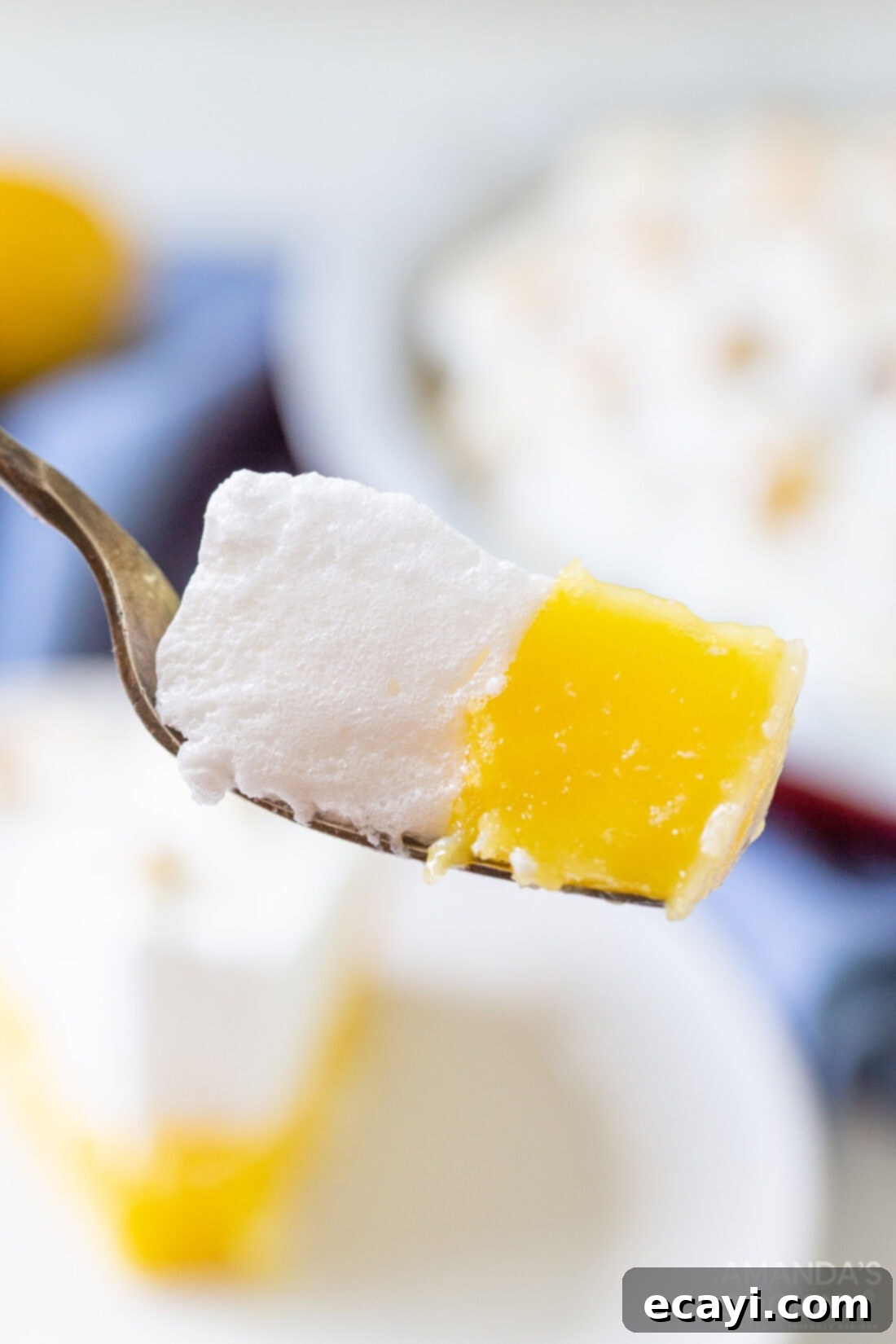
Lemon meringue pie truly shines as a Thanksgiving favorite, adding a bright, zesty counterpoint to richer holiday flavors. But its refreshing qualities make it a delightful dessert year-round, especially during the warmer summer months when vibrant lemon-flavored treats are particularly appealing. This pie is a celebration of fresh, bold flavors and elegant textures, perfect for any occasion.
More Irresistible Dessert Recipes
If you have a sweet tooth and enjoyed this lemon meringue pie, you’re in luck! Here are some other fantastic pie and dessert recipes to satisfy your cravings and expand your baking repertoire:
- Classic Blueberry Pie: A timeless favorite bursting with sweet, juicy berries.
- Zesty Key Lime Pie: Another tangy citrus pie, perfect for warm weather.
- Creamy Banana Cream Pie: A rich, comforting pie with layers of fresh bananas and smooth custard.
- Perfect Pumpkin Pie: The quintessential holiday dessert, perfectly spiced and smooth.
- Hearty Homemade Apple Pie: A classic comfort food, with tender apples and a flaky crust.
- No-Bake Peanut Butter Pie: An easy and indulgent pie for peanut butter lovers.
- Luxurious Homemade French Silk Pie: A rich, chocolatey, and incredibly smooth pie.
- Quick Instant Pot Lemon Curd: A versatile and vibrant lemon curd, perfect for various desserts.
- Delightful Lemon Baked Donuts: A lighter, zesty treat for breakfast or dessert.
I genuinely love to bake and cook, and my passion is sharing my kitchen experiences and delicious recipes with all of you! Remembering to come back each day for new culinary inspiration can be tough, which is why I offer a convenient newsletter every time a new recipe posts. Simply subscribe today and start receiving your free daily recipes directly to your inbox!
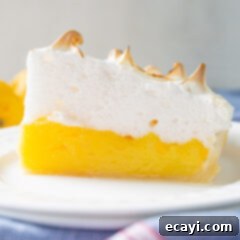
Classic Lemon Meringue Pie
IMPORTANT – There are often Frequently Asked Questions within the blog post that you may find helpful. Simply scroll back up to read them!
Print It
Pin It
Rate It
Save ItSaved!
Ingredients
- 1 pie crust 9 inch (pre-made or homemade)
- 1 ½ cup granulated sugar
- ¼ teaspoon salt
- 7 Tablespoons cornstarch
- 1 ½ cups hot water
- 4 egg yolks beaten (from large eggs, at room temperature)
- 4 Tablespoons unsalted butter (cut into small pieces)
- 1 teaspoon fresh lemon zest
- ½ cup fresh lemon juice (about 3-4 squeezed lemons)
Meringue Topping
- 4 egg whites (from large eggs, at room temperature)
- 1 Tablespoon granulated sugar (for meringue)
- ½ teaspoon cream of tartar
Equipment You’ll Need
-
Hand mixer or stand mixer with whisk attachment
-
9-inch Pie plate
-
Medium Saucepan
-
Whisk
-
Optional: Handheld kitchen torch
Before You Begin
- For the best meringue volume and stability, ensure egg whites are at room temperature and your mixing bowl is absolutely clean and grease-free.
- Lemon meringue pie will keep beautifully in the refrigerator for 2-3 days. Cover loosely with plastic wrap.
- We do not recommend freezing a fully assembled lemon meringue pie, as the meringue tends to become watery upon thawing. However, you can freeze the baked crust and lemon custard separately for future assembly.
Instructions
-
Prepare and Bake the Crust: Unroll your pie crust into a 9-inch pie plate. Prick the bottom and sides with a fork. Line with parchment paper and fill with pie weights or dried beans. Bake according to package instructions until golden. Remove weights and parchment; cool completely.
-
Start the Lemon Custard: In a saucepan over medium-low heat, combine sugar, salt, and cornstarch. Slowly add hot water, whisking continually for 5-10 minutes until thick and smooth. Remove from heat.
-
Temper Egg Yolks: In a separate bowl, whisk beaten egg yolks. Gradually whisk in 1/4 cup of the hot cornstarch mixture to the egg yolks, then continue adding until about half is incorporated. Pour the tempered egg yolk mixture back into the saucepan with the remaining cornstarch mixture. Add butter. Whisk over medium-low heat until butter is melted and custard is thick.
-
Flavor the Custard: Remove from heat and whisk in the fresh lemon zest and lemon juice until combined.
-
Chill the Custard: Pour the custard into the baked pie crust. Cover with plastic wrap, pressing it directly onto the surface to prevent a skin from forming. Chill in the refrigerator for at least 2 hours, or until completely set.
-
Whip Egg Whites: In a clean, dry bowl using a handheld or stand mixer on high speed, beat the room temperature egg whites until frothy.
-
Add Cream of Tartar: Add cream of tartar and continue beating on medium-high speed until soft peaks form.
-
Gradually Add Sugar for Meringue: Slowly sprinkle in the granulated sugar (1-2 tablespoons at a time) on low-medium speed, beating well after each addition until sugar is fully incorporated. Continue beating until the meringue is glossy and forms stiff, firm peaks that hold their shape. The meringue should not feel grainy.
-
Top the Pie: Dollop the meringue over the completely set and chilled pie. Spread the meringue evenly, ensuring it touches the crust all around the edges to seal the filling. Use the back of a spoon or spatula to create decorative peaks and swirls.
-
Brown the Meringue: Use a handheld kitchen torch to lightly brown the meringue peaks. Alternatively, place the pie under a low broiler in the oven for 1-2 minutes, watching carefully to prevent burning.
-
Slice and Serve: Allow to cool slightly if broiled. Slice with a hot, clean knife and serve immediately for the best experience.
Nutrition Information
The recipes on this blog are tested with a conventional gas oven and gas stovetop. It’s important to note that some ovens, especially as they age, can cook and bake inconsistently. Using an inexpensive oven thermometer can assure you that your oven is truly heating to the proper temperature. If you use a toaster oven or countertop oven, please keep in mind that they may not distribute heat the same as a conventional full sized oven and you may need to adjust your cooking/baking times. In the case of recipes made with a pressure cooker, air fryer, slow cooker, or other appliance, a link to the appliances we use is listed within each respective recipe. For baking recipes where measurements are given by weight, please note that results may not be the same if cups are used instead, and we can’t guarantee success with that method.
